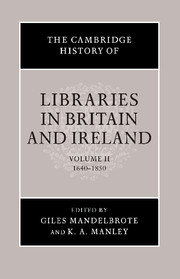Book contents
- Frontmatter
- 1 Introduction: the changing world of libraries – from cloister to hearth
- PART ONE THE EXPANSION OF BOOK COLLECTIONS 1640–1750
- PART TWO LIBRARY DEVELOPMENT AT A LOCAL LEVEL
- PART THREE PROVINCIAL AND METROPOLITAN LIBRARIES 1750–1850
- 18 Libraries in context: social, cultural and intellectual background
- 19 The book trade and libraries
- 20 Ecclesiastical libraries
- 21 Libraries in the parish
- 22 Books and universities
- 23 Libraries and literacy in popular education
- 24 Scientific and medical libraries: the rise of the institution
- 25 The first century of the British Museum library
- 26 The impact of the British Museum library
- 27 Private libraries in the age of bibliomania
- 28 Library architecture and interiors
- 29 Library management in the pre-professional age
- 30 Libraries for an imperial power
- 31 Engines of literature: libraries in an era of expansion and transition
- Select bibliography
- Index
- References
27 - Private libraries in the age of bibliomania
from PART THREE - PROVINCIAL AND METROPOLITAN LIBRARIES 1750–1850
Published online by Cambridge University Press: 28 March 2008
- Frontmatter
- 1 Introduction: the changing world of libraries – from cloister to hearth
- PART ONE THE EXPANSION OF BOOK COLLECTIONS 1640–1750
- PART TWO LIBRARY DEVELOPMENT AT A LOCAL LEVEL
- PART THREE PROVINCIAL AND METROPOLITAN LIBRARIES 1750–1850
- 18 Libraries in context: social, cultural and intellectual background
- 19 The book trade and libraries
- 20 Ecclesiastical libraries
- 21 Libraries in the parish
- 22 Books and universities
- 23 Libraries and literacy in popular education
- 24 Scientific and medical libraries: the rise of the institution
- 25 The first century of the British Museum library
- 26 The impact of the British Museum library
- 27 Private libraries in the age of bibliomania
- 28 Library architecture and interiors
- 29 Library management in the pre-professional age
- 30 Libraries for an imperial power
- 31 Engines of literature: libraries in an era of expansion and transition
- Select bibliography
- Index
- References
Summary
One word – bibliomania – seems to sum up the great private libraries of the late eighteenth and early nineteenth centuries. The word was already being used in England as early as 1734, when Thomas Hearne commented on the low prices fetched by the manuscripts at the sale of Thomas Rawlinson’s library – ‘had I been in place I should have been tempted to have laid out a pretty deal of money, without thinking myself at all touched with Bibliomania’ – but it is more commonly associated with the early nineteenth century, the period celebrated in Thomas Frognall Dibdin’s Bibliomania (1811), when the prices of rare books in England rose to unprecedented heights. It has been succinctly and accurately defined by Marc Vaulbert de Chantilly as ‘the rage for rare, curious and splendid books which gripped a number of wealthy, well-educated and well-born Englishmen over a period of approximately fifty years’, between about 1775 and 1825. Like the Dutch ‘tulipomania’ of the late seventeenth century, the English bibliomania of the early nineteenth century has often been seen as a brief and exceptional period of unbridled extravagance, when books were bought and sold at prices far exceeding their intrinsic value. There is certainly a good deal of truth in this view; but as I hope to show in this chapter, the era of bibliomania was not merely a blip in the history of English book-collecting. On the contrary, it represents a profound shift in literary taste, and has had an equally profound and enduring impact on the collecting of books and the formation of libraries.
- Type
- Chapter
- Information
- The Cambridge History of Libraries in Britain and Ireland , pp. 438 - 458Publisher: Cambridge University PressPrint publication year: 2006
References
- 5
- Cited by



